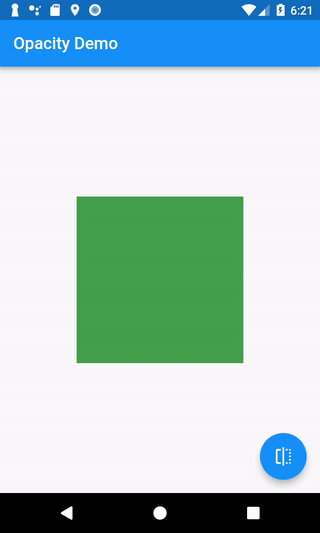您好,欢迎关注我,本篇文章是关于 Flutter 的系列文,从简单的 Flutter 介绍开始,一步步带你了解进入 Flutter 的世界。你最好有一定的移动开发经验,如果没有也不要担心,在我的专栏底部给我留言,我会尽我的能力给你解答。
上篇文章我们介绍了Flutter的整体架构,相信大家一定印象深刻,本篇文章介绍 Flutter UI的基础构建,从主题、提示、图片加载和动画四个方向介绍。
一.使用主题管理颜色和字体样式
使用主题可以在应用中采用统一的颜色和样式。定义主题有两种方式:内建主题或自定义Theme类。
1.内建主题
new MaterialApp(
title: title,
theme: new ThemeData(
brightness: Brightness.dark,
primaryColor: Colors.lightBlue[800],
accentColor: Colors.cyan[600],
),
);2.自定义主题
new Theme(
// Create a unique theme with "new ThemeData"
data: new ThemeData(
accentColor: Colors.yellow,
),
);3.使用主题
通过以上两种方式创建主题后,我们可以在Widget的build方法中通过Theme.of(context)函数使用主题。
new Container(
color: Theme.of(context).accentColor,
child: new Text(
'Text with a background color',
style: Theme.of(context).textTheme.title,
),
);通过ThemeData文档可以查看到主题里面支持预定义的颜色
通过TextTheme可以查看系统预制的字体样式。例如示例中提到的theme.textTheme.title就是这个样子的:
SnackBar
在Android中有Toast弹出提示这个概念,但是在Flutter中没有Toast,取而代之的是SnackBar。
想要创建一个SnackBar,我们需要用到Scaffold容器,之前文章有讲过Scaffold是一个包含Material Design的容器。
Scaffold(
appBar: AppBar(
title: Text('SnackBar Demo'),
),
body: SnackBarPage(), // We'll fill this in below!
);接下来创建一个按钮:
return Center(
child: RaisedButton(
onPressed: _showSnackBar,
child: Text('Show SnackBar'),
),
);点击按钮的时候显示SnackBar:
void _showSnackBar() {
final snackBar = SnackBar(
content: Text('Yay! A SnackBar!'),
action: SnackBarAction(
label: 'Undo',
onPressed: () {
// Some code to undo the change!
},
),
);
Scaffold.of(context).showSnackBar(snackBar);
}二.从网络加载图片
在Flutter中直接使用Image.network就可以加载图片了
import 'package:flutter/material.dart';
void main() => runApp(MyApp());
class MyApp extends StatelessWidget {
@override
Widget build(BuildContext context) {
var title = 'Web Images';
return MaterialApp(
title: title,
home: Scaffold(
appBar: AppBar(
title: Text(title),
),
body: Image.network(
'https://github.com/flutter/website/blob/master/_includes/code/layout/lakes/images/lake.jpg?raw=true',
),
),
);
}
}该方法还可以直接加载GIF图片
Image.network(
'https://github.com/flutter/plugins/raw/master/packages/video_player/doc/demo_ipod.gif?raw=true',
);通过placeholder属性可以增加一个占位图:
FadeInImage.assetNetwork(
placeholder: 'assets/loading.gif',
image: 'https://github.com/flutter/website/blob/master/_includes/code/layout/lakes/images/lake.jpg?raw=true',
);值得注意的是用Image.network加载的图片并没有缓存,如果想加载图片并缓存,需要使用:
CachedNetworkImage(
placeholder: CircularProgressIndicator(),
imageUrl: 'https://github.com/flutter/website/blob/master/_includes/code/layout/lakes/images/lake.jpg?raw=true',
);如果对Flutter的图片缓存策略感兴趣,请继续关注本专栏,之后的文章中我会分享给大家
三.动画
本段只简单的介绍动画入门,之后有文章会详细介绍Flutter动画。
上篇文章说到过在Flutter中所有的东西都是Widget,包括动画也不例外,如果你想让某个Widget包含动画属性,那么你需要用AnimatedOpacity将其包裹起来,AnimatedOpacity也是一个Widget。
AnimatedOpacity(
// If the Widget should be visible, animate to 1.0 (fully visible). If
// the Widget should be hidden, animate to 0.0 (invisible).
opacity: _visible ? 1.0 : 0.0,
duration: Duration(milliseconds: 500),
// The green box needs to be the child of the AnimatedOpacity
child: Container(
width: 200.0,
height: 200.0,
color: Colors.green,
),
);我们使用一个StatefulWidget来调用setState()方法刷新_visible的值,就能显示动画了,是不是很简单?
import 'package:flutter/material.dart';
void main() => runApp(MyApp());
class MyApp extends StatelessWidget {
@override
Widget build(BuildContext context) {
final appTitle = 'Opacity Demo';
return MaterialApp(
title: appTitle,
home: MyHomePage(title: appTitle),
);
}
}
// The StatefulWidget's job is to take in some data and create a State class.
// In this case, our Widget takes in a title, and creates a _MyHomePageState.
class MyHomePage extends StatefulWidget {
final String title;
MyHomePage({Key key, this.title}) : super(key: key);
@override
_MyHomePageState createState() => _MyHomePageState();
}
// The State class is responsible for two things: holding some data we can
// update and building the UI using that data.
class _MyHomePageState extends State<MyHomePage> {
// Whether the green box should be visible or invisible
bool _visible = true;
@override
Widget build(BuildContext context) {
return Scaffold(
appBar: AppBar(
title: Text(widget.title),
),
body: Center(
child: AnimatedOpacity(
// If the Widget should be visible, animate to 1.0 (fully visible). If
// the Widget should be hidden, animate to 0.0 (invisible).
opacity: _visible ? 1.0 : 0.0,
duration: Duration(milliseconds: 500),
// The green box needs to be the child of the AnimatedOpacity
child: Container(
width: 200.0,
height: 200.0,
color: Colors.green,
),
),
),
floatingActionButton: FloatingActionButton(
onPressed: () {
// Make sure we call setState! This will tell Flutter to rebuild the
// UI with our changes!
setState(() {
_visible = !_visible;
});
},
tooltip: 'Toggle Opacity',
child: Icon(Icons.flip),
), // This trailing comma makes auto-formatting nicer for build methods.
);
}
}
本篇文章从主题、提示、图片加载和动画四个方面简单的介绍了Flutter的UI创建过程,为了避免文章太长导致可读性较差,所以只简单的讲了这四个方面,还有更多内容会在之后的文章里介绍。相信本篇文章读完之后,你已经知道如何使用Flutter Widget了,下一篇专栏来点实战,我会教大家如何实现一个轮播指示器。